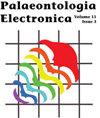古近纪和新近纪三个长期化石物种叶片性状的紫杉醇特异性变异:对气候的反应?
IF 1.5
4区 地球科学
Q1 Earth and Planetary Sciences
引用次数: 3
摘要
气候敏感性叶片性状数据通常是对整个化石叶片组合进行收集和分析的,也包括对环境条件的种内响应。气候与叶片性状的种内相关性既代表了个体水平上的可塑性响应,也代表了一个物种的离散居群之间遗传差异所引起的可塑性。正如对现存植物的各种研究所证明的那样,可塑性是分类特异性的。然而,关于化石植物可塑性的数据很少。在这项研究中,利用来自奥地利、捷克共和国和德国的16个地点的材料,追踪了三个长距离物种的气候敏感叶片特征的可塑性,每个物种都覆盖了从中始新世晚期到晚渐新世甚至中新世早期的较长时间间隔。所选分类群为褐皮藻、褐皮藻、褐皮藻、褐皮藻。叶片大小相关数据(叶片大小、长度、宽度)以及叶片形状相关数据(质心、长宽比和“圆度”的两个参数)被考虑在内。所有三个被考虑的化石物种在叶片大小相关性状和叶片形状相关性状上都表现出不同的地点特异性和显著差异。来自异域海洋沉积物的数据显示出最高的可塑性,可能是由于来自不同生长地点的异质植物物质的积累。渐新世和中新世的结果与古温度数据基本一致。“圆度”数据尤其如此,证实了这一特征作为气候指标的适用性。始新世发现的各种特征的高度变异性很难单独归因于温度。相反,始新世特征数据的相当大的变异性可能是由于气候过渡期间的环境不稳定,例如降水模式的变化。ROTH-NEBELSICK等人:分类群特异性变异2 Anita ROTH-NEBELSICK。德国斯图加特国立自然博物馆,罗森斯坦1,70191。anita.rothnebelsick@smns-bw.de Michaela Grein。Übersee-Museum不莱梅,班霍夫广场13号,28195不莱梅,德国。m.grein@uebersee-museum.de Christopher Traiser。德国本文章由计算机程序翻译,如有差异,请以英文原文为准。
Taxon-specific variability of leaf traits in three long-ranging fossil-species of the Paleogene and Neogene: Responses to climate?
Data of climate-sensitive leaf traits, which are usually collected and analyzed for entire fossil leaf assemblages, also include intraspecific responses to environmental conditions. Intraspecific correlations between climate and leaf traits represent plastic responses on the individual level as well as plasticity caused by genetic differences between disjunct populations of a species. Plasticity is taxon-specific, as documented by various studies on extant plants. Data on plasticity in fossil plants are, however, rare. In this study, the plasticity of climate-sensitive leaf traits of three long-ranging species, each covering an extended time interval from the late middle Eocene to the late Oligocene or to even the early Miocene, were tracked by using material from 16 sites located in Austria, Czech Republic and Germany. Selected taxa are Daphnogene cinnamomifolia, Eotrigonobalanus furcinervis and Platanus neptuni. Leaf size-related data (lamina size, length, width) as well as leaf shape-related data (centroid, length-to-width ratio and two parameters for “roundness”) were considered. All three considered fossilspecies show various site-specific and significant differences for leaf size-related traits as well as for leaf shape-related traits. Data from allochthonous marine deposits show the highest plasticity, probably due to the accumulation of heterogeneous plant material from different growing sites. For the Oligocene and Miocene, the results are mostly consistent with palaeo-temperature data. This is particularly the case for “roundness” data, confirming the suitability of this trait as an indicator for climate. The high variability of various traits found for the Eocene is, however, difficult to attribute to temperature alone. Rather, the considerable variability of Eocene trait data may be explained by environmental instability during climate transition, such as changing precipitation patterns. ROTH-NEBELSICK ET AL.: TAXON-SPECIFIC VARIABILITY 2 Anita Roth-Nebelsick. State Museum of Natural History, Rosenstein 1, 70191 Stuttgart, Germany. anita.rothnebelsick@smns-bw.de Michaela Grein. Übersee-Museum Bremen, Bahnhofsplatz 13, 28195 Bremen, Germany. m.grein@uebersee-museum.de Christopher Traiser. Department of Geoscience, University of Tübingen, Schnarrenbergstr. 94-96, 72076 Tübingen, Germany. christopher.traiser@uni-tuebingen.de Lutz Kunzmann. Senckenberg Natural History Collections Dresden, Königsbrücker Landstr. 159, 01109 Dresden, Germany. lutz.kunzmann@senckenberg.de Jiří Kvaček. National Museum Prague, Václavské náměsti 68, 115 79 Prague 1, Czech Republic. jiri.kvacek@nm.cz Janina Wypich. State Museum of Natural History, Rosenstein 1, 70191 Stuttgart, Germany; Janina.wypich@smns-bw.de Johanna Kovar-Eder. State Museum of Natural History, Rosenstein 1, 70191 Stuttgart, Germany. johanna.eder@smns-bw.de
求助全文
通过发布文献求助,成功后即可免费获取论文全文。
去求助
来源期刊

Palaeontologia Electronica
地学-古生物学
CiteScore
3.60
自引率
0.00%
发文量
20
审稿时长
>12 weeks
期刊介绍:
Founded in 1997, Palaeontologia Electronica (PE) is the longest running open-access, peer-reviewed electronic journal and covers all aspects of palaeontology. PE uses an external double-blind peer review system for all manuscripts. Copyright of scientific papers is held by one of the three sponsoring professional societies at the author''s choice. Reviews, commentaries, and other material is placed in the public domain. PE papers comply with regulations for taxonomic nomenclature established in the International Code of Zoological Nomenclature and the International Code of Nomenclature for Algae, Fungi, and Plants.
 求助内容:
求助内容: 应助结果提醒方式:
应助结果提醒方式:


